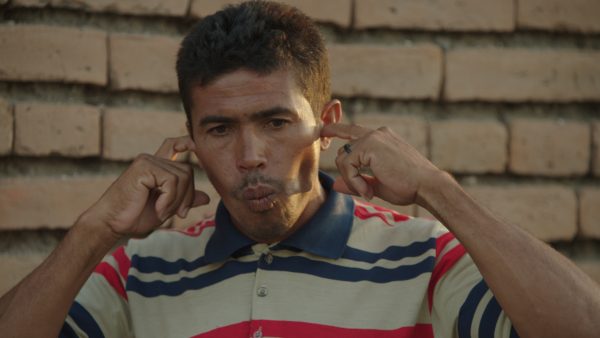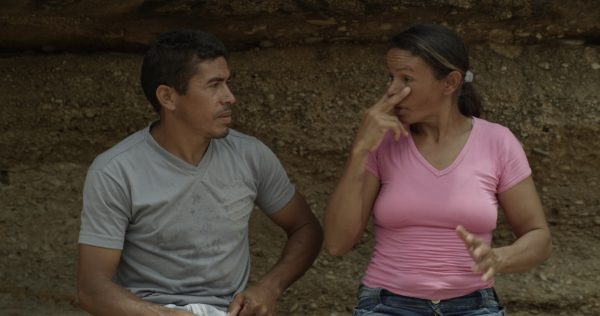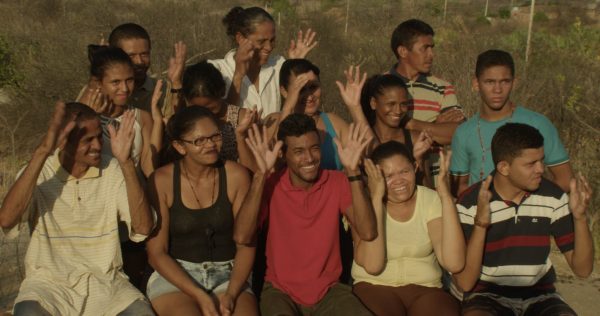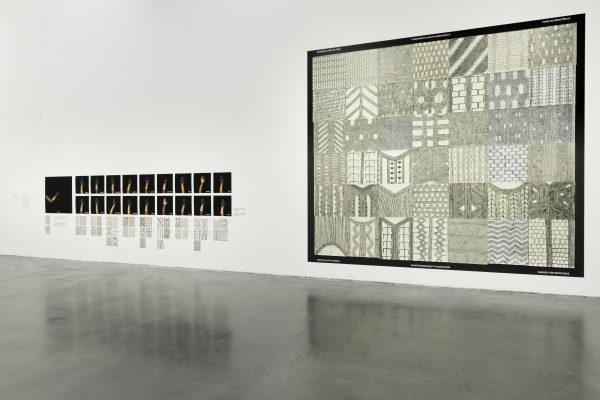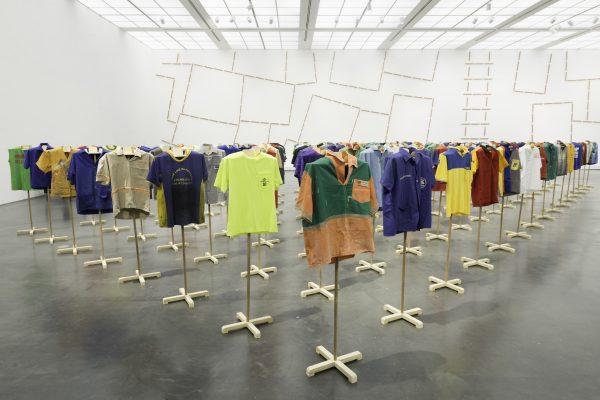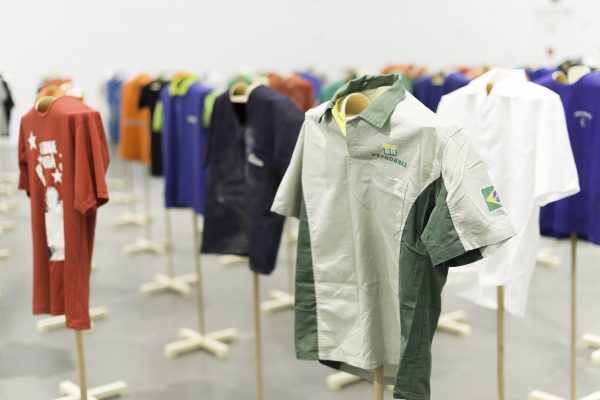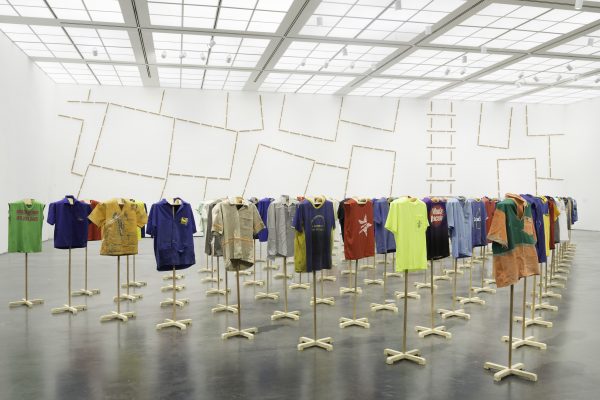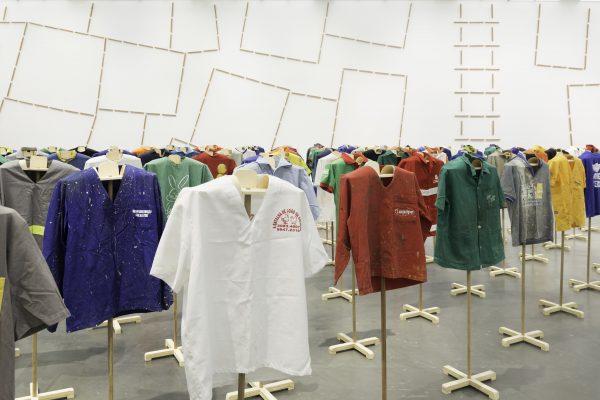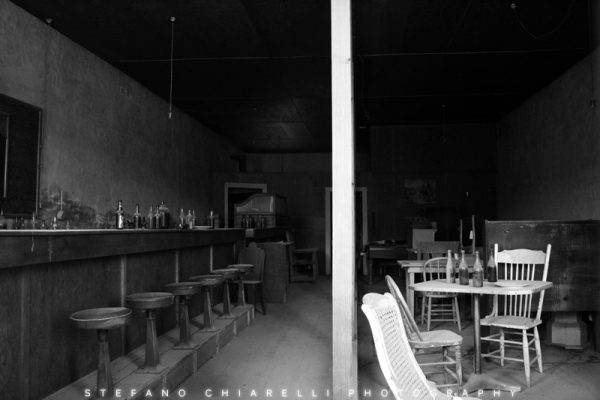A collection of workers’ shirts, mounted like shopping displays and gathered into the regimented, brightly coloured rows that might mark a labour demonstration, stands as the centrepiece of Jonathas de Andrade’s solo exhibition One to One (2019), at the Museum of Contemporary Art, Chicago (MCA). The shirts are men’s. Paint daubs and sweat stains trail across them, and the work, Suar a camisa (Working up a sweat) (2014), captures much of the dense, reticent logic of de Andrade’s art.
De Andrade acquired the shirts from male workers in the streets of Recife and the countryside of Brazil’s Nordeste, his home city and region, and a cohering local force in his art. He would approach workers on their off hours, as they travelled to work or commuted home, clearly attracted by the shirts’ vividness, their lambent yellows or soiled oranges, as well as their ability to signify – they appear worn, sturdy, industrial, as if they’ve just emerged from under the hood of a car. Striking up conversations with the men, he would begin a line of inquiry: could he buy their shirt, or propose a deal, or – the preferred option – exchange his own for theirs? It’s hard to imagine the exchange coming to fruition, and yet the process resulted in de Andrade receiving 120 shirts, hung on poles and assembled in the centre of MCA’s gallery, a crowd of hollow figures.
The work unfolds in layers, and my first impression was of a kind of startling political presence, as if 120 working men stood at the centre of MCA. Here, it seemed, was a sincere and wishful image of the working class, its labour expressed through the sweat-marks and enlivened into the collective form of a workers’ protest. But as I circled the installation, a contradictory possibility soon shadowed my optimistic impression as presence gave way to a more definitive sense of absence. Not a popular uprising but shirts without bodies, dead labour rather than labour, adding up not to working-class potency but its waning or disorganisation. This feeling was made more potent by the recent election of Jair Bolsonaro, Brazil’s far-right president, who came to power in October 2018 bolstered by the support of working class voters who had abandoned the leftist Worker’s Party (PT) amid an erosion of trade union power.
Some of the interplay of presence and absence in Suar a camisa is explained by Nordeste, a leitmotif that surfaces here and elsewhere in de Andrade’s work, and a region that holds a mythical space in the Brazilian popular imagination. Nordeste, which means the northeast, is Brazil’s poorest region: an arid landscape of sugarcane plantations, cattle ranches and textile industries. Once a key coordinate of a colonial slave economy, it remains beset by vast inequalities across the vectors of race and class. Today, Nordeste represents centuries of exploitation, and, almost simultaneously, the fantastical sublimation of hardship into a fetishised image of working-class man. In de Andrade’s words, the region signifies ‘a worker, a brute strong man, that works with force, with his arms and hands’ – a silent, macho, romanticised figure making his solitary way through inhospitable climes. De Andrade has plumbed Nordeste’s masculine image before: in the video O Peixe (The Fish) (2016), in which shirtless fishermen tenderly suffocate fish, and Museo do Homem do Nordeste (Museum of the Man of Nordeste) (2013), a fictional recreation of an existing museum that takes the title literally, turning galleries into faux-institutions dedicated to examining Nordeste’s masculinity.
A similar approach occurs in Suar a camisa. Importantly, the installation does not give an image of the working class – many of whom are women, engaged in gendered and wageless forms of labour, such as housework – but rather rows of disembodied men. We’re meant to pause over the work with a divided mind, struck by its material index of labour and hints of an uprising, but troubled by its hollowness, its simplified masculinity, the way the mere sight of a sweat-stained worker’s shirt can conjure up a whole figure, or a whole fetish – ‘a worker, a brute strong man’ and so on: commodified labour given a sexualised cast. And this is where the act of exchanging shirts shades into the installation. Against the working-class male stereotype’s rigid confines, the intimacy of exchange opens up a half-hidden world of feeling as the image begins to queer, impressing the assembly of shirts with the quiet air of homoeroticism.
Questions of community and its limits also figure in the film Jogos dirigidos (Directed Games) (2019), commissioned by MCA. Set in a remote town in Nordeste with a large population of deaf people, Jogos dirigidos takes the form of a mock-educational video. A group of deaf individuals gather in a browning landscape of tall grass and sparse trees to play schoolyard games and tell each other stories via a self-taught sign language. We see them blindfolded, touching each other’s faces and guessing identities; playing hide and seek; huddling together on benches. De Andrade doesn’t allow his audience to feel at ease. At times the signs go untranslated; at others the video pauses, a single sign slowing down into a flash-card-like frame and accompanied by a kind of martial arts movie soundtrack, body movements linked to hyperbolic sounds that play up the translation’s artifice and leave us amused and anxious, uncertain of the joke’s intention, but aware we might be its target. The irony and gaps in translation keep viewers at a remove, but above all a sense of community pervades, and as the video pans across the landscape it evokes a new image of Nordeste: one still rooted in struggle but defined also by solidarity and social pleasure, the spectre of masculinity and the reality of exploitation temporarily out of view.
